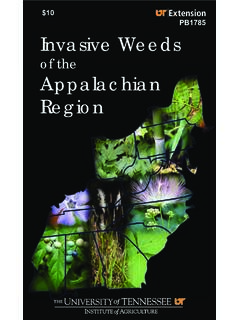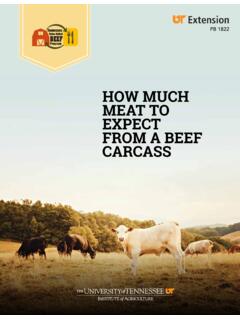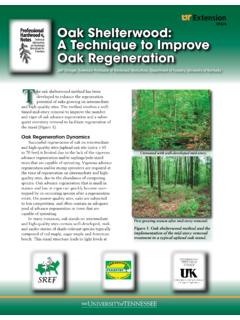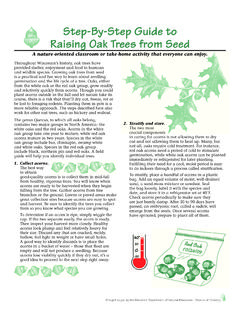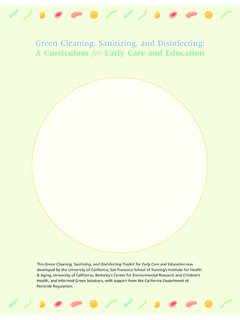Transcription of Extension Perilla Mint
1 Extension W135. Perilla Mint Larry Steckel, Assistant Professor, Plant Sciences Neil Rhodes, Professor and Department Head, Plant Sciences Perilla Mint Peri indicutescens (L.) Britt. Also known as: beefsteak plant, common Perilla , purple Perilla , purple mint, shiso, Chinese basil, wild basil, blueweed, Joseph's coat, wild coleus, rattlesnake weed Classification and Description Perilla mint is a member of the Lamiaceae or mint family. About 200 genera and 3200 species make up the mint plant family. Perilla mint is an erect, herbaceous annual that can grow to heights of 2 feet. It is native to East Asia. The cotyledons are longer than they are broad, with the broadest portion near the tip. The leaves are simple, opposite and can be purple or green tinged with purple, making it an attractive plant. Leaves have coarsely serrated (toothed) leaf margins pointed toward the tip and can be up to 5 inches wide and 7 inches long.
2 Leaves are egg-shaped, with the largest part nearest the Perilla mint base. The stems of Perilla mint are square in cross section, erect, hairy, somewhat branched and green or purple. Many small, white to purplish-white flowers with a ring of hairs in the throat are clustered in the terminals of these plants. Reproduction is by seed . Perilla mint has a shallow taproot and fibrous roots. Weed Status and Injury Perilla mint causes more cattle deaths in Tennessee than any other toxic plant. Perilla is very poisonous to cattle and other ruminants, as well as horses. All plant parts are toxic, especially the flowering structures. Dried plants in hay can be toxic, but the greatest risk is associated with consumption of fresh plant material, especially if flowers and fruit are present. Perilla mint contains ketones that cause acute respiratory distress syndrome in cattle (ARDS), also called panting disease.
3 Treatment is often ineffective. Although these plants can occur anywhere in a pasture or feed lot, they typically favor semi-shaded Perilla mint growing along fence line of a pasture environments, and are most frequently located around farm structures, edges of woods and along fence rows. Interesting Facts Cases of poisoning from these weeds are a concern The Latin word frutescens means shrubby or bushy during the late summer and early fall when other grasses and refers to this plant's growth habit. Perilla mint is and forages might be in short supply and the Perilla mint considered an ornamental plant and it is cultivated for its is flowering. Cattle will normally not feed on these toxic often variegated purple and green foliage. It is an escaped weeds unless there is a shortage of other feed. Therefore, ornamental and that is how it has become a weed pest in it is crucial to have a ready supply of quality feed available Tennessee.
4 These plants give off a distinctive, aromatic, for farm animals during this time of the year. minty odor when the stems and leaves are crushed. It is a Flowering branches of Perilla mint cultivated crop in East Asia. The seed is used for cooking References oil and fuel. It has a square stem that is characteristic of the Burrows, G. E. and R. J. Tyrl. 2001. Toxic Plants of plants in the mint family. Another interesting fact, though North America. Iowa State University Press, 2121 S. State not recommended by the University of Tennessee, is that Ave., Ames, Iowa 50014. 1342 p. Native Americans of the Rappahannock tribe used Perilla Gleason, H. A. and A. Cronquist. 1963. Manual of mint (as a drug) as an ingredient of a blood medicine. vascular plants. PWS Publishers. Boston, MA 02116. Pp 810. Moerman, 1998. Native American Ethnobotany. Management Considerations Timber Press. The Haseltine Bldg., 133 S.
5 W. Second Ave., Control of Perilla mint in pastures, barn lots and Suite 450, Portland, OR 97204, forage fields is very important. The best time to scout Rhodes, G. N., G. K. Breeden, G. Bates and S. McElroy. for and control Perilla mint is late April to early June. It 2006. Hay Crop and Pasture Weed Management Guide. is very difficult to control in late summer and early fall University of Tennessee Extension Publication. PB1521. when it also becomes the most dangerous to livestock. If control measures are not taken early, it becomes even more crucial in late summer to maintain an adequate supply of quality feed for cattle and other farm animals so they will not feed on these toxic weeds. Grazing in infested pastures should be limited during late summer when Perilla mint is flowering. Avoid harvesting forages in areas infested with these weeds. Mowing Perilla mint plants before seed is produced will help prevent further reproduction and spread.
6 Please refer to the Weed Control Manual for Tennessee Row Crops ( Extension PB 1580) for management recommendations. Another good resource for management of this weed is in the Hay Crop and Pasture Weed Management Guide ( Extension PB 1521). 07-0061. Programs in agriculture and natural resources, 4-H youth development, family and consumer sciences, and resource development. University of Tennessee Institute of Agriculture, Department of Agriculture and county governments cooperating. UT Extension provides equal opportunities in programs and employment.
